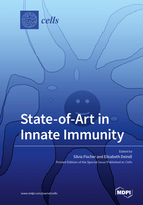State-of-Art in Innate Immunity
A special issue of Cells (ISSN 2073-4409). This special issue belongs to the section "Cellular Immunology".
Deadline for manuscript submissions: closed (25 July 2022) | Viewed by 35382
Special Issue Editors
Interests: homeostasis; extracellular nucleic acids; vascular endothelium; inflammation; DAMPs
Special Issues, Collections and Topics in MDPI journals
Interests: cardiovascular research; immunology
Special Issues, Collections and Topics in MDPI journals
Special Issue Information
Dear Colleagues,
The innate immune system is the first line of defence against pathogens and protects against bacterial and viral infections through the recognition of pathogen-associated molecular patterns (PAMPs), which recruit and activate pathogen recognition receptors (PRRs) resulting in the production of proinflammatory and antiviral cytokines and chemokines. Additionally, PRRs are recognized by damage-associated molecular patterns (DAMPs), which were released by passive or active mechanisms under sterile conditions such as shear stress, ischemic injuries, trauma, or tumors. Once released, DAMPs serve as alarmins by triggering inflammation, dendritic cell maturation, activation of immune cells, and promoting regeneration and remodeling processes. DAMPs involve nuclear or cytosolic proteins such as histones, high mobility group box 1 (HMGB1), adenosine triphosphate, DNA, or RNA and can also be used as biomarkers to indicate and monitor a disease or injury severity. During infectious diseases, DAMPs can even aggravate the inflammatory response, whereby the initial hyperinflammatory phase is counterbalanced by an anti-inflammatory response, which is possibly caused by the production of suppressing/inhibiting inducible DAMPs (SAMPs).
The present issue aims to demonstrate new advances in the mechanisms of DAMP and SAMP release under sterile conditions as well as the consequences of their extracellular innate immune signaling and activities. Furthermore, the usefulness of DAMPs/SAMPs as biomarkers for special diseases and as therapeutic targets to decrease hyperinflammatory processes will be summarized.
Dr. Silvia Fischer
Dr. Elisabeth Deindl
Guest Editors
Manuscript Submission Information
Manuscripts should be submitted online at www.mdpi.com by registering and logging in to this website. Once you are registered, click here to go to the submission form. Manuscripts can be submitted until the deadline. All submissions that pass pre-check are peer-reviewed. Accepted papers will be published continuously in the journal (as soon as accepted) and will be listed together on the special issue website. Research articles, review articles as well as short communications are invited. For planned papers, a title and short abstract (about 100 words) can be sent to the Editorial Office for announcement on this website.
Submitted manuscripts should not have been published previously, nor be under consideration for publication elsewhere (except conference proceedings papers). All manuscripts are thoroughly refereed through a single-blind peer-review process. A guide for authors and other relevant information for submission of manuscripts is available on the Instructions for Authors page. Cells is an international peer-reviewed open access semimonthly journal published by MDPI.
Please visit the Instructions for Authors page before submitting a manuscript. The Article Processing Charge (APC) for publication in this open access journal is 2700 CHF (Swiss Francs). Submitted papers should be well formatted and use good English. Authors may use MDPI's English editing service prior to publication or during author revisions.
Keywords
- inflammation
- sterile injury
- damage-associated molecular pattern
- DAMP








